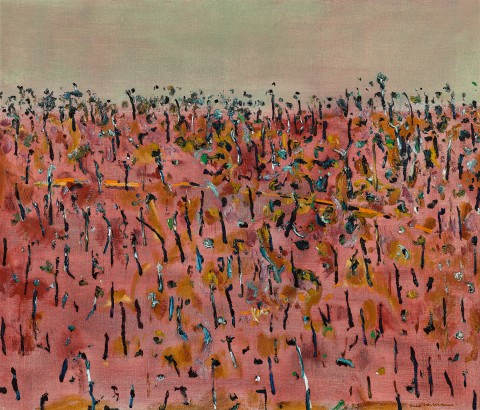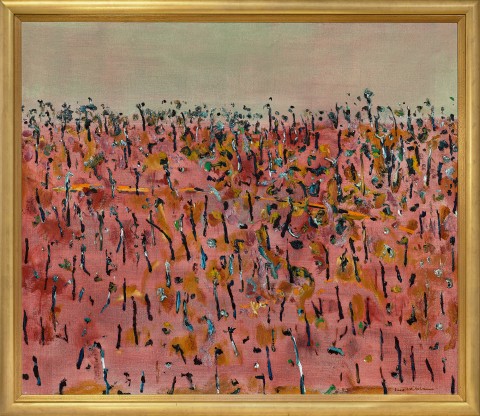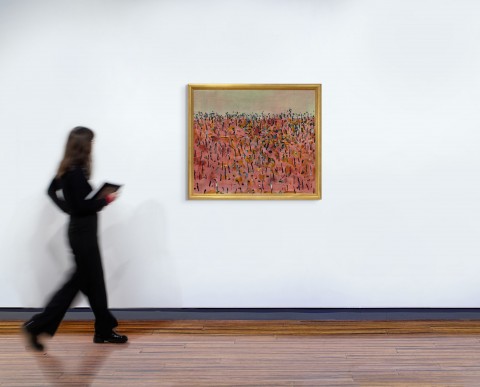(1927 - 1982)
Fred Williams
Burnt hillside, 1968 – 69
oil on canvas
Skinner Galleries, Perth
Private collection, Perth, acquired from the above in 1970
Melbourne Art Exchange, Melbourne
Private collection, Melbourne, acquired from the above in May 1984
Fred Williams: Perth Festival Exhibition, Skinner Galleries, Perth, 23 February - 16 March 1970, cat. 15
We are grateful to Lyn Williams for her assistance with this catalogue entry
1968 was an annus mirabilis for the painter Fred Williams, already recognised as Australia’s leading landscapist.1 Unhampered by the pressure of creating work for an annual exhibition, his painting practice flourished under an extensive campaign of outdoor sketching in this, the artist’s last year of living rurally, at Upwey in the Dandenong Ranges where he had lived since 1963. Stimulated by a variety of motifs discovered during excursions into the landscape, as far as the Mornington Peninsula and Tibooburra in outback New South Wales, Williams created during this year several distinct series of paintings. Working rapidly and methodically in making complete sets of paintings, gouaches, drawings and prints of each theme, Williams’ landscape works of this time were the climactic expressions of current events interwoven with formal investigations that had underpinned the works of the early 1960s. Working surrounded by older paintings in the studio allowed the artist to refer back to earlier approaches and solutions to painting the landscape, creating a fertile and interconnected body of work at this time. In June 1968, Williams wrote in his diary, ‘I have been painting full-time now for five years, and the sixth promises to be the best.’2
The grand and chromatically vibrant Burnt hillside, 1968 presents a view of the landscape of the Dandenong Hills around Upper Ferntree Gully and Upwey, stilled and denuded by two successive bushfires that had threatened the artist’s home in early 1968. Topographically, the area is characterised by steep hills rising abruptly from the surrounding plains; their northern and western faces, heavily timbered with combustible native trees, are exposed to strong, dry winds during summer. The wildfires sweeping through the region in February and March 1968 were fuelled by high summer temperatures and a prolonged drought, leaving acres of bushland incinerated and dozens of homes lost. Fred Williams’ direct and indelible experience of the advancing fire front and its path through his beloved landscape led to the feverish creation of his most emotive and atmospheric paintings and a new perception of the Australian landscape.
Throughout 1968 and 1969, the altering effects of the fires captivated Williams. He painted freely to record the events in a storyboard fashion, advancing towards the hopeful green shoots of regeneration. First introduced in Williams’ early Upwey paintings in 1963, a simplified composition of a high horizon, a narrow band of sky running across the top of a featureless treed slope, reappears in Burnt hillside and its sister works from the series. Painting en plein air with friends Hal Hattam, Ian Armstrong and Harry Rosengrave, Williams noticed how the landscape had suddenly opened up, the absence of ferny undergrowth on the steep hillside now providing clear sightlines through the tree trunks and over the horizon. Burnt hillside’s refined and uninterrupted view is painted from a distance, without any distinct pictorial focus. The many trunks of still-standing trees are delicately placed atop a thinly washed, matte orange ground of horizontal strokes, the empty spaces between them prefiguring the decorative spareness and extreme minimalism of Williams’ later Australian Landscape works. In August 1968, Williams adopted a smaller format of 36 x 42 inches. This new format, when combined with the Upwey compositional structure, imparted a more literal expression of scale, the density of the forest increasing towards the horizon, lacy daubs of canopies hovering above it. Painted with striking beauty, these were Williams’ most naturalistic landscapes, returning to a traditional landscape format with the same monumental proportions as Cézanne’s landscapes of Mont Sainte-Victoire.3
Far from the gauzy greys of his previous works, Fred Williams in 1968 delighted in the ‘sonorous colours’ of the transformed landscape ‘slowly turning green and orange.’4 Consequently, he adopted new saturated hues of green chromium oxide and Indian Red into his palette, placed alongside titanium white in the modelled staccato daubs describing charred silhouettes. While many of the gouache studies of this time featured ashy grounds using found charcoal, Burnt hillside’s arresting and warmly glowing burnt sienna ground bears similarities with the radiant reds of earlier Pond in landscape works and the rich red grounds of the concurrent works from Tibooburra. Interrupting this visual unity is a dynamic and enlivening diagonal streak of bright orange – the familiar arcing hillside motif, a dominant component within Williams’ mature landscape paintings of this period.
Williams’ Burnt hillside, although appearing impersonal in its panoramic amplitude and deep space, was painted with moving grandeur. It describes the artist’s awestruck reverence and understanding of the power of the ordinary Australian landscape. Shimmering and seemingly still smouldering, the strange colours and altered infrastructure of vegetation of the artist’s vista are painted with referential clarity, the line of trees bisecting the canvas reduced to slight apostrophes of paint on a pale horizon.
1. O’Brien, D., ‘The etchings of a landscapist’, The Bulletin, Sydney, vol. 90, no. 4615, 17 August 1968, p. 77
2. Fred Williams, cited in McCaughey, P., and Timlin, J., The Diaries of Fred Williams. 1963 – 1970, The Miegunyah Press, Melbourne, 2024, p. 348
3. Mollison, J., A Singular Vision: The Art of Fred Williams, Australian National Gallery and Oxford University Press, Canberra, 1989, p. 138
4. McCaughey and Timlin, ibid., p. 337
LUCIE REEVES-SMITH


